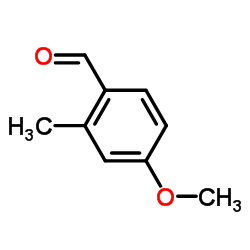| Structure | Name/CAS No. | Articles |
|---|---|---|
 |
4-Methoxy-2-methylbenzaldehyde
CAS:52289-54-0 |
Tamer Awad, Jack DeRuiter, C Randall Clark
Index: J. Chromatogr. Sci. 45(8) , 458-65, (2007)
Full Text: HTML
The methoxy methyl phenylacetones share an isobaric relationship (equivalent mass but different elemental composition) to the controlled precursor substance 3,4-methylenedioxyphenylacetone. The 10 methoxy methyl phenylacetones as well as the methylenedioxyphenylacetones show essentially equivalent mass spectra with major fragment ions at m/z 135 and 43. Those methoxy methyl phenylacetones with the methoxy group substituted ortho to the benzylic cation in the m/z 135 ion show a further fragmentation to lose formaldehyde (CH2O) and yield a significant ion at m/z 105. The loss of formaldehyde from the ortho methoxy benzyl cation was confirmed using commercially available regioisomeric 2-, 3-, and 4-methoxyphenylacetones. The 10 regioisomeric methoxy methyl phenylacetones were prepared from the appropriately substituted benzaldehydes. Complete gas chromatographic resolution of all ten regioisomeric ketones was obtained on a stationary phase containing modified beta-cyclodextrin. Using the cyclodextrin containing phase, the ortho methoxy-substituted ketones (K1-K4) eluted before the meta-methoxy-substituted ketones (K5-K8) and the para-methoxy-substituted ketones (K9-K10) showed the greatest affinity for the stationary liquid phase and eluted last. Complete separation of the 10 ketones was not obtained on Rtx-1 and Rtx-200 columns.
| Structure | Name/CAS No. | Molecular Formula | Articles |
|---|---|---|---|
 |
4-Methoxy-2-methylbenzaldehyde
CAS:52289-54-0 |
C9H10O2 |
|
Antifungal activity of redox-active benzaldehydes that targe...
2011-01-01 [Ann. Clin. Microbiol. Antimicrob. 10 , 23, (2011)] |
|
Compounds of potential interest for the chemotherapy of lepr...
[J. Org. Chem. 21(4) , 415-418, (1956)] |
|
Estrogenic Biphenyls. III. 2-Alkyl-4-methoxybiphenyl-4'-carb...
[Bull. Chem. Soc. Jpn. 30(8) , 859-862, (1957)] |
Home | MSDS/SDS Database Search | Journals | Product Classification | Biologically Active Compounds | Selling Leads | About Us | Disclaimer
Copyright © 2024 ChemSrc All Rights Reserved